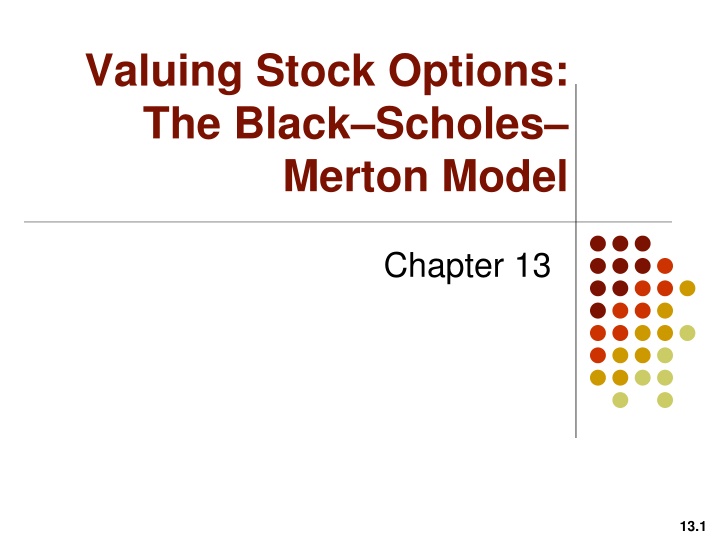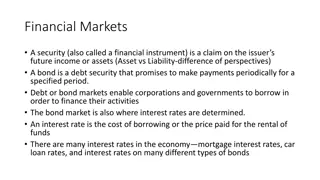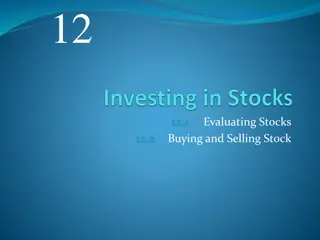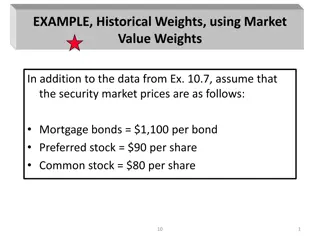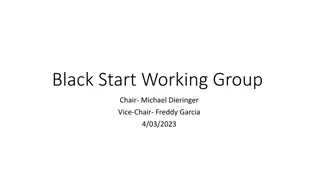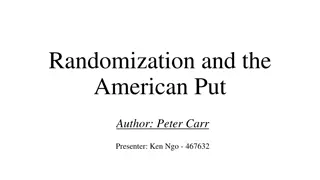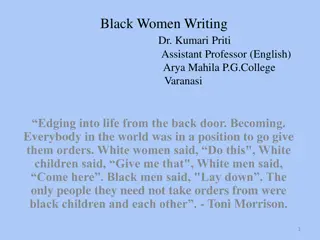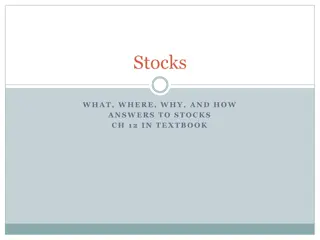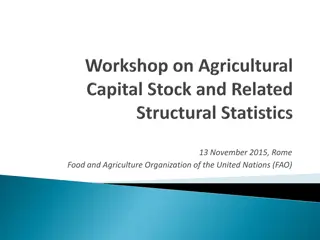Valuing Stock Options Using the Black-Scholes-Merton Model
This chapter delves into the intricacies of valuing stock options through the renowned Black-Scholes-Merton model. Learn about the key principles, equations, and factors involved in determining the value of stock options. Gain insights into the complexities of option pricing and enhance your understanding of financial modeling in the context of stock markets.
Download Presentation

Please find below an Image/Link to download the presentation.
The content on the website is provided AS IS for your information and personal use only. It may not be sold, licensed, or shared on other websites without obtaining consent from the author.If you encounter any issues during the download, it is possible that the publisher has removed the file from their server.
You are allowed to download the files provided on this website for personal or commercial use, subject to the condition that they are used lawfully. All files are the property of their respective owners.
The content on the website is provided AS IS for your information and personal use only. It may not be sold, licensed, or shared on other websites without obtaining consent from the author.
E N D
Presentation Transcript
Valuing Stock Options: The Black Scholes Merton Model Chapter 13 13.1
Goals of Chapter 13 The stock price distribution in Black Scholes Merton (BSM) model and the estimation of its parameters The risk-neutral valuation relationship (RNVR) and BSM option pricing formula Extension of RNVR on pricing forward contracts Implied volatilities ( ) of options Effects of cash dividends or dividend yield on option values 13.2
13.1 Distribution of the Stock Price in Black Scholes Merton Model 13.3
Distribution of The Stock Price In 1973, Fischer Black, Myron Scholes, and Robert Merton achieved a major breakthrough in pricing European options They developed pricing formulas for European options, which are known as the Black Scholes Merton (or simply Black Scholes) model Merton and Scholes won Nobel Prize in 1997 with this achievement This chapter presents the Black Scholes Merton model for valuing European calls and puts on a non-dividend-paying stock first 13.4
Distribution of The Stock Price Based on the RNVR and given a constant ?, any derivative can be priced as the PV of its expected payoff in the risk-neutral world Consider a European call option, its value today is ? = ? ???[max(?? ?,0)|in the risk neutral world] = ? ?? 0 where ? ?? is the probability density function (PDF) of ?? in the risk-neutral world Therefore, to identify the distribution and thus the PDF of ??in the risk-neutral world is the critical step to derive the option pricing formula max ?? ?,0 ? ?????, 13.5
Distribution of The Stock Price The distribution of ?? of the BSM model in the real world The BSM model considers a non-dividend-paying stock and assumes the return on the stock in a short period of time is normally distributed, i.e., ? ?~??(? ?,?2 ?), where ? is the change in the stock price in a short period of time ?, the mean of the return is ? ?, and the standard deviation of the return is ? ? (Note that it is the variance of the return, not the standard deviation, that is proportional to ?) 13.6
Distribution of The Stock Price The assumption of the normal distribution of the stock return implies that ?? is lognormally distributed as follows ln??~??(ln?0+ ? ?2 ?[??] = ?ln ?0+ ? ?2 (consistent with what we learned before) For ln ? ~??(?,?2), ?[?] = ??+?2/2 and the probability ?? 2?? 1 Rewriting the above distribution leads to the distribution of the log return (or said log difference) in the stock price ln?? ln?0~??((? ?2 ?,?2?) 2 ?+?2? 2= ?ln ?0+??= ?ln ?0???= ?0??? 2 2 ln? ? ? 1 density function ? ? = 2 ?0~??((? ?2 2)?,?2?) ln?? 2)?,?2?) 13.7
Distribution of The Stock Price How to interpret ? ?2 2 and ?? ?0~??(? ?2 For simplicity, ln?1 2,?2) given ? = 1 year Suppose ?1 to be the annual continuously compounding return provided by the stock asset, so ?1= ?0??1 1 We can derive ln?1 ?0= ?1 and thus ?1~??(? ?2 2,?2), so ? ?2 2 and ? can be interpreted as the mean and standard deviation of annual continuously compounding return ?1 (also known as the log return of the stock price), respectively 13.8
Distribution of The Stock Price Estimate ? ?2 stock prices Suppose the length of the time interval between the observations of stock prices is ?, i.e., we have the series of ??,??+?,??+2?, ,??+?? Therefore, there are ? observations of the log returns of the stock prices ?1= ln??+? 2 and ? using a series of historical ??,?2= ln??+2? ??+?,?3= ln??+3? ??+?? ??+(? 1)? ??+2?, ,??= ln The lognormally distributed result on the bottom of Slide 13.7 can be extended to any two time points ? and ? + ?, i.e., ln??+? ??~??((? ?2 2)?,?2?) and thus ??~??((? ?2 2)?,?2?) for ? = 1, ,? 13.9
Distribution of The Stock Price ??+?? ??+ ? 1 ? can The arithmetic average and variance of ??= ln be used to estimate (? ?2 (? ?2 2)? = ? = ?? =1 ?(ln?1+ ln?2+ + ln??) = ln((?1?2 ??) ? ?2 2= (Note that (? ?2 stock returns) (in continuous compounding) ?2? = ?2= ? 1 ?=1 ?2=?2 ? ? = ? 2)? and ?2?, respectively + ln??+2? ??+?+ + ln 1 ?(ln??+? ??+?? ??+ ? 1 ?) 1 ?) = ln(??1?2 ??) ? ? 2) is the annualized geometric average of the 1 ?(?? ?)2 ? 13.10
Distribution of The Stock Price Suppose that returns in successive 5 years are 15%, 20%, 30%, 20% and 25% The geometric average of the annual returns is 12.40% (= ? ?2 2 in annual compounding) Based on the formula on Slide 13.10, ? ?2 11.69% (expressed in continuously compounding) The transformation to continuous compounding results can be derived from ??= ? ln 1 +?? 11.69% = 1 ln 1 +12.40% 1 ? ?= ? 1= 2= ? with ? = 1, i.e., 13.11
Distribution of The Stock Price Trading days vs. Calendar days Usually the daily observations of stock prices are used to estimate ? ?2 2 and ? Since the variation (or the volatility) of stock prices occurs only on trading days, so only trading days are counted to estimate ? ?2 When the market is closed, the variation of stock prices is zero # of trading days per year and the number of trading days in a year is usually to be 252 in the U.S. Finally, ? ?2 2= Note that if the number of calendar days is used, then ? ?2 2= ? 365 and ? = ? 365 are overestimated 2 and ? 1 As a result, ? is set to ? ?= ? 252 and ? = ? ?= ? 252 13.12
13.2 Risk-Neutral Valuation Relationship and Black Scholes Merton option pricing formulae 13.13
RNVR and BSM model Assumptions underlying the BSM model Stock price behavior follows the lognormal model mentioned on Slides 13.6 and 13.7 There are no transaction costs or taxes All securities are perfectly divisible, e.g., you can buy 0.00013 stock shares There are no dividends on the stock in [0,?] There are no riskless arbitrage opportunities Security can be traded continuously The risk-free interest rate, ?, is constant in [0,?] Investors can borrow or lend at ? unlimitedly 13.14
RNVR and BSM model RNVR states that given a constant ?, any derivative can be priced as the PV of its expected payoff if it and its underlying asset were in the risk-neutral world Without dividend payments, the stock return in the risk-neutral world is ?, i.e., ? ?~??(? ?,?2 ?) Then, the lognormal distribution of ?? becomes ln??~??(ln?0+ (? ?2 2)?,?2?) 13.15
RNVR and BSM model Thus, the probability density function for the lognormally distributed ?? is 2 ln?? (ln ?0+ ? ?2 ? ? ?) ??? ? 2?? 1 2 1 ? ?? = 2 In addition, based on RNVR, the risk-free interest rate should be employed to discount the expected payoff of any derivative As a result, European calls can be valued as ? = ? ???[max(?? ?,0)|in the risk neutral world] = ? ?? 0 = ? ?? ? max ?? ?,0 ? ?????, (?? ?)? ????? 13.16
RNVR and BSM model European puts can be valued as ? =? ?? 0 The BSM option price formulas can be derived by evaluating the above two integrals: ? = ?0? ?1 ?? ???(?2), ? = ?? ??? ?2 ?0? ?1, ln ?0/? + ?+?2/2 ? ? ? ln ?0/? + ? ?2/2 ? ? ? ?(? ??)? ????? where ?1= = ?1 ? ? ?2= 13.17
RNVR and BSM model ?(?) is the cumulative distribution function for the standard normal distribution It returns the probability for a random variable following the standard normal distribution to be less than a constant ? ? ? ? ?? = probability density function of the standard normal distribution 1 2?? 1 2?2??, where ? ? is the ? ? ? = ?(?) ?(?) ? ? ? needs to be solved with numerical techniques In Excel 2019 or later versions, NORM.S.DIST(?,1) returns ? ?and NORM.S.DIST(?,0) returns ? ? In the final exam, a table to find ? ? will be offered 13.18
RNVR and BSM model European calls and puts converge to their lower bounds when they are extremely ITM or OTM As ?0 becomes very large, calls (puts) are extremely ITM (OTM) ?1,?2 ? ?1,? ?2 1 ? ?1,?( ?2) 0 The call value ? = ?0? ?1 ?? ??? ?2 ?0 ?? ?? The put value? = ?? ??? ?2 ?0? ?1 0 As ?0 becomes very small, calls (puts) are extremely OTM (ITM) ?1,?2 ? ?1,? ?2 0 ? ?1,?( ?2) 1 The call value ? = ?0? ?1 ?? ??? ?2 0 The put value? = ?? ??? ?2 ?0? ?1 ?? ?? ?0 13.19
RNVR and BSM model A full proof of the BSM formulas is beyond the scope of this course In fact, Black and Scholes derived the option pricing formula in another way which is similar to what the binomial tree model does Basic idea is to construct a riskless portfolio by determining proper weights for the option and its underlying asset This is because the option price and the underlying asset price share the same source of uncertainty The portfolio is instantaneously riskless and must instantaneously earn the risk-free rate Thus, a partial differential equation ( ) is derived, and the solution of it is the BSM option pricing formula 13.20
RNVR and BSM model Similar to the binomial tree model, the procedure to derive the BSM model also leads to the RNVR The no arbitrage argument implies the return of the riskless portfolio should be the risk free interest rate Therefore, we can obtain that the expected growth rates for both the underlying asset price and the option price are the same to be the risk-free interest rate As a result, an option can be priced as if it and its underlying asset were in the risk neutral world The general rule (given a constant ?) to price an option as the PV of its expected payoff in the risk neutral world, i.e., ? ???[payoff(??)|in the risk neutral world], is actually the unique solution of the partial differential equation derived in the BSM model 13.21
13.3 Apply Risk-Neutral Valuation Relationship to Pricing Forward Contracts 13.22
RNVR for Forward Contracts The RNVR is valid for pricing all derivatives, including futures, forwards, swaps, and options Three steps to evaluate any derivative with the general rule of the RNVR: ? ??? payoff ?? in the risk neutral world Step 1: Identify the payoff function of the derivative Step 2: When calculating the expected payoff, assume that the expected growth rate of the underlying asset price is the risk-free rate Step 3: Discount the expected payoff at the risk-free rate 13.23
RNVR for Forward Contracts Apply the RNVR to deriving the theoretical value of the forward contracts today Consider a long forward contract that matures at time ? with the delivery price ? Step 1: The payoff of the contract at maturity is ?? ? Step 2: The expected payoff in the risk-neutral world is ?[?? ?|in the risk neutral world] = ?[??|in the risk neutral world] ? = ?0??? ? Step 3: The theoretical value of the forward contract today is ? = ? ???0??? ? = ?0 ?? ?? The above formula is identical to the formula of the forward value (for the underlying asset without any income) on Slide 5.30 13.24
13.4 Implied Volatility 13.25
Implied Volatility The only unobservable parameter in the BSM pricing formulas is the stock price volatility BSM s parameters include ?0, ?, ?, ?, and ? The implied volatility (IV) of an option is defined as the volatility for which the BSM option price equals the market price The is a one-to-one correspondence between prices and IVs Use the bisection method ( ) to solve the IV given ?0= 21, ? = 20, ? = 0.1, ? = 0.25, and ? = 1.9 The implied volatility is 24.2% The IV of an option contract DOES depend on its strike price and time to maturity 13.26
Implied Volatility The IV reflects the consensus of traders in the option market regarding the volatility of the underlying asset price for a future period Option prices are determined by the option traders investment decisions, which are formed based on their estimation of stock price volatility in the future option life The IV is a forward-looking estimation, which is the expected volatility in the following option life The historical volatility (see Slides 13.9 and 13.10) works well only if the price behavior of the underlying asset in the immediate future is the same as that in the recent past Often quote IVs rather than dollar prices Facilitate identifying overvalued or undervalued options, e.g., you estimate the volatility in the future option life is 30% vs. IV is 24.2% the option is undervalued to you 13.27
Implied Volatility VIX (volatility index) CBOE publishes indices of implied volatilities The most popular index, the S&P VIX, is an index of the implied volatility of 30-day S&P 500 index options calculated from a wide range of calls and puts S&P VIX, normally ranging between 15% and 25%, can be interpreted as the expectation of the volatility of the S&P 500 index in the future one month Trading in futures on the VIX started in 2004 and trading in options on the VIX started in 2006 Note that the underlying asset of those derivatives is the VIX index, which is not a tradable asset 0.01 index points (0.01% in volatility) gains/losses $1013.28
13.5 Effects of Cash Dividends or Dividend Yield on Option Values 13.29
Effects of Cash Dividend Payments on Option Prices European options on dividend-paying stocks are valued by substituting ?0 for ?0 ?0 in the BSM or the binomial tree models ?0 is the sum of the PV (discounted at ?) of the dividend payments during the life of the option Note that this technique is used to determine the forward price in Ch. 5 and to modify the lower bounds and the put-call parity of options in Ch. 10 Reasons for this replacement method: Note that that on the ex-dividend dates ( ), the stock prices are expected to reduce by the amounts of the dividend payments 13.30
Effects of Cash Dividend Payments on Option Prices Therefore, the distributions of ?? are identical under the following two situations 1. The initial stock price is ?0 and there are dividend payments ?? s during the life of the option 2. The initial stock price is ?0 ?0 and there is no dividend payment during the life of the option Since the value of a European option depends on the distribution of ?? as ? ???[payoff(??)|in the risk neutral world] = ? ?? 0 it can be expected that the option value should be the same under the above two situations due to the identical probability density function ? ?? payoff(??)? ?????, 13.31
Effects of Cash Dividend Payments on Option Prices For American options, it can be priced with only some numerical methods like the binomial tree model To take the dividend payments into account, the technique of replacing ?0 with ?0 ?0 is no more valid This is because in order to make optimal early exercise decisions, we need the correct probability distribution of the stock price at all time points ?, which cannot be achieved by the replacement of ?0 with ?0 ?0 13.32
Effects of Cash Dividend Payments on Option Prices Fischer Black proposed an approximation for the value of an American call based on the BSM model if there are dividend payments during the life of the option The well-known early exercise behavior of American calls An American call on a non-dividend-paying stock should never be exercised early An American call on a dividend-paying stock should only be exercised immediately prior to an ex-dividend date 13.33
Effects of Cash Dividend Payments on Option Prices Approximate the American call equal to the maximum of two European option prices: 1. The 1st European option price is for an option maturing at the same time as the American option 2. The 2nd European option price is for an option maturing just before the final ex-dividend date (The strike price, initial stock price, risk-free interest rate, and the volatility are the same for the options under consideration) Note that the binomial tree model can evaluate American calls or puts accurately with proper modifications for dealing with the cash dividend payments (beyond the scope of this course) 13.34
(Material in Ch. 15) European Options on Stocks Paying Dividend Yields The same probability distribution for the stock price can be obtained at time ? in each of the following cases: 1. The stock starts at price ?0 and provides a dividend yield ? To reflect the decline in the stock price due to the dividend yield payment, the expected growth rate of the stock price becomes ? ? 2. The stock starts at price ?0? ?? and provides no dividend payments Check: ?[??] in the first case is ?0?? ? ? and ?[??] in the second case is ?0? ?? ???= ?0?? ? ? 13.35
(Material in Ch. 15) European Options on Stocks Paying Dividend Yields Recall the general pricing rule based on the RNVR, i.e., ? ???[payoff(??)|in the risk neutral world] = ? ?? 0 Since the above two cases are with the identical probability density function ? ??, the option values are the same under these two cases payoff ??? ????? 13.36
(Material from Ch. 15) European Options on Stocks Paying Dividend Yields To take the dividend yield into account, we simply modify the BSM formulas on Slide 13.17 by replacing ?0 with ?0? ?? and then obtain ? = ?0? ??? ?1 ?? ???(?2), ? = ?? ??? ?2 ?0? ??? ?1, ln ?0? ??/? + ?+?2/2 ? ? ? ln ?0? ??/? + ? ?2/2 ? ? ? = ?1 ? ? ln ?0/? + ? ?+?2/2 ? ? ? ln ?0/? + ? ? ?2/2 ? ? ? where ?1= = ?2= = 13.37
